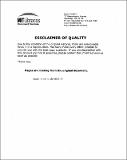| dc.contributor.advisor | Roger D. Kamm and Mohammad R. Kaazempur-Mofrad. | en_US |
| dc.contributor.author | Hsu, Jeffrey J | en_US |
| dc.contributor.other | Massachusetts Institute of Technology. Dept. of Mechanical Engineering. | en_US |
| dc.date.accessioned | 2006-05-15T20:37:01Z | |
| dc.date.available | 2006-05-15T20:37:01Z | |
| dc.date.issued | 2005 | en_US |
| dc.identifier.uri | http://hdl.handle.net/1721.1/32886 | |
| dc.description | Thesis (S.B.)--Massachusetts Institute of Technology, Dept. of Mechanical Engineering, 2005. | en_US |
| dc.description | "June 2005." | en_US |
| dc.description | Includes bibliographical references (p. 41-43). | en_US |
| dc.description.abstract | Introduction: Cells are exposed to a wide variety of forces within the human body, and the mechanisms by which cells respond to these forces are largely unknown. From altering gene transcription in the cell nucleus to conformational changes in membrane channel proteins that lead to increased or decreased ion permeability, external stresses imposed on the cell can significantly affect cellular actions through a process known as "mechanotransduction." While such cellular actions include fundamental processes such as cell motility and protein production, the cellular response to external forces can also be pathogenic. For instance, plaque formation within the arteries often occurs at points where the arteries branch or bend sharply, or rather, where cells are subjected to low or reversing fluid shear stresses. | en_US |
| dc.description.statementofresponsibility | by Jeffrey J. Hsu. | en_US |
| dc.format.extent | 43 p. | en_US |
| dc.format.extent | 1971024 bytes | |
| dc.format.extent | 1971003 bytes | |
| dc.format.mimetype | application/pdf | |
| dc.format.mimetype | application/pdf | |
| dc.language.iso | eng | en_US |
| dc.publisher | Massachusetts Institute of Technology | en_US |
| dc.rights | M.I.T. theses are protected by copyright. They may be viewed from this source for any purpose, but reproduction or distribution in any format is prohibited without written permission. See provided URL for inquiries about permission. | en_US |
| dc.rights.uri | http://dspace.mit.edu/handle/1721.1/7582 | |
| dc.subject | Mechanical Engineering. | en_US |
| dc.title | Viscoelastic two-dimensional modeling of cell deformation due to shear stress on apical focal adhesion, with experimental design considerations | en_US |
| dc.title.alternative | Viscoelastic 2-dimensional modeling of cell deformation due to shear stress on apical focal adhesion, with experimental design considerations | en_US |
| dc.title.alternative | Viscoelastic 2D modeling of cell deformation due to shear stress on apical focal adhesion, with experimental design considerations | en_US |
| dc.type | Thesis | en_US |
| dc.description.degree | S.B. | en_US |
| dc.contributor.department | Massachusetts Institute of Technology. Department of Mechanical Engineering | |
| dc.identifier.oclc | 62616334 | en_US |
